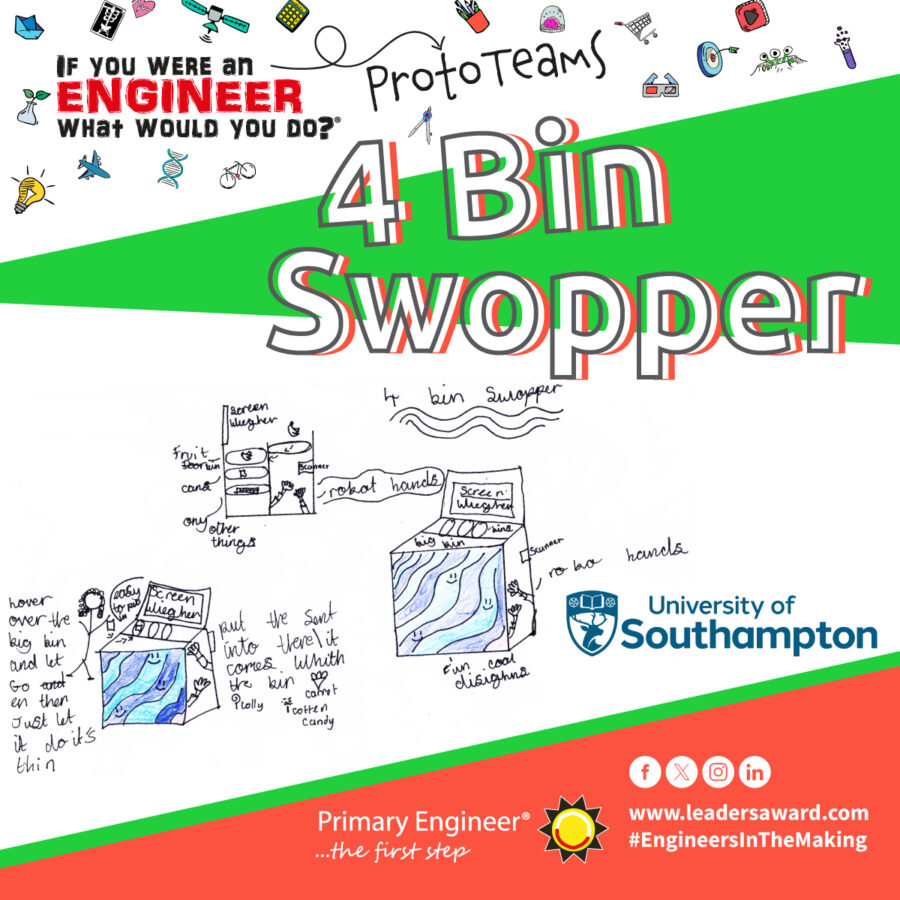
University of Southampton creating The 4 Bin Swopper prototype – Midpoint Update!
Where we left off…
A team of five final-year engineering students at the University of Southampton began designing a smart recycling bin inspired by Maisie’s ‘4 bin swopper’ concept. The team investigated current smart bin designs and the needs of primary schools, then began prototyping a mechanism to photograph and sort individual waste items into four compartments. They also created a CAD model of the bin and presented it to Maisie, who supported adding child-designed illustrations to the bin’s compartments to make recycling more engaging!
Midpoint Update!
And now we’re halfway there! The prototype of the Smart Recycling Bin, based on Maisie’s brilliant “4-bin swopper” concept, is coming to life — and the progress is exciting.
As of March 2025, the sub-systems were being assembled and tested before being integrated into the main build of the Smart Recycling Bin. They began testing to ensure the waste items deposited can be photographed, the images can be recognised, and the sorting box can move to deposit the item automatically in one of four receiving containers, ready for collection!
Here’s what’s in the works so far:
- Subsystems Built & Tested: Core components are being assembled and trialed — including a belt and rail mechanism mounted on a lightweight aluminum frame that moves the sorting box into position.
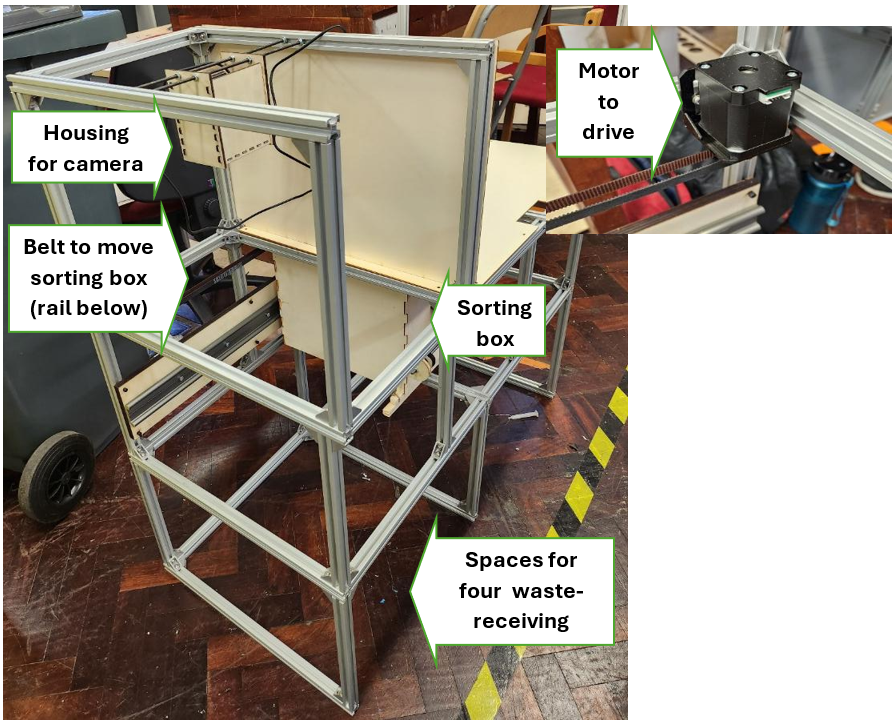
- Brainpower Inside: The bin is powered by a Raspberry Pi mini computer. It runs software that’s learning to recognise waste items using images from a connected webcam.

- Smart Sorting: With around 5,000 images for each of 27 waste categories (like glass bottles, paper, cans, and even food waste), the bin has been “trained” to figure out what you’re throwing away.
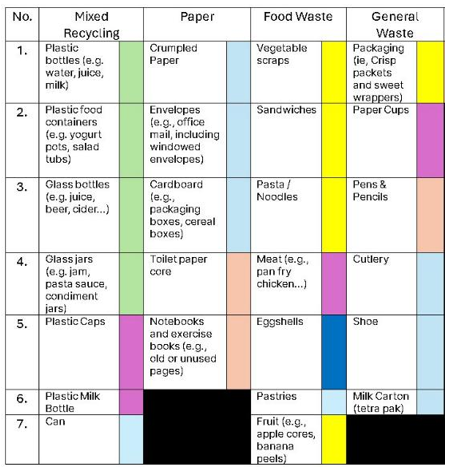
- Interactive screen: When you use the bin, you’ll be asked to guess which bin your waste goes into. The system then checks your guess and tells you if you were right! This fun feedback loop helps everyone get better at recycling.
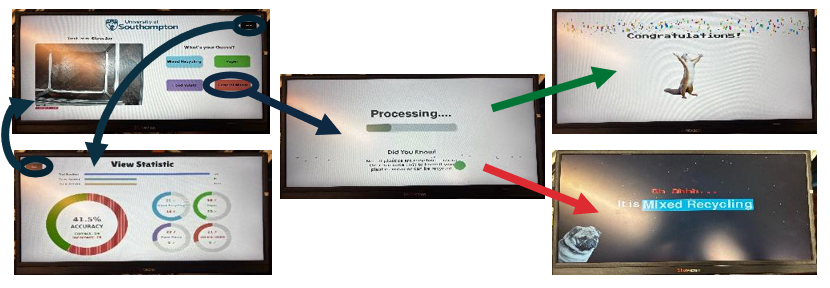
Obstacles that have been faced, overcame or anticipated!
As the Smart Recycling Bin prototype nears completion, the University of Southampton student team continues to learn and adapt — not just from testing, but from the wider community. Engaging a broader range of users, particularly busy Primary School teachers, has been challenging, which made the visit to Evendons Primary School especially meaningful. The students gained practical insights from the school’s existing recycling setup and were grateful for the thoughtful questions and suggestions from Maisie’s class and teachers. On the technical side, the team tackled several design challenges with creative solutions and helpful partnerships. A key issue involved moving the sorting box smoothly while ensuring the electrical wiring remained secure and unobstructed. Guidance from igus, a manufacturer of plastic bearing systems and cable management solutions, proved instrumental—they offered advice and sample parts like linear rails and e-chains, which greatly helped. Another major consideration was selecting containers to receive the four categories of waste; they had to be large enough, easy to handle, and still fit within the prototype’s frame. Each of these developments adds to the learning experience, contributing to a more robust and thoughtful final design.
Humans vs. AI: The Recycling Showdown
At the Science & Engineering Day on March 15, visitors of all ages faced a fun challenge:
“Can you sort recycling faster than AI?”
Armed with a mixed pile of everyday waste items, families had 30 seconds to correctly sort as many items as they could into four recycling categories. Some older kids managed to sort more than 20 items, racing against the clock — although the pressure made it very tempting to take a few lucky guesses for a spot on the leaderboard!
This sparked a great question:
How fast is the Smart Recycling Bin?
Right now, the bin is expected to be slower than a person, since its sorting box travels between bins and handles one item at a time. But in the long run, it may be more accurate. As testing continues, the team will compare the AI’s performance to human scores from the event.

Visiting Evendons Primary School
Just a few days later, the student team made a much-anticipated visit to Evendons Primary School!
They gave a project update to Maisie and her classmates, showing how her idea is taking shape. The students asked lots of fantastic questions and shared brilliant suggestions for ways to improve the bin even further.
The team also spoke with teachers to understand how the Smart Bin could work best in a real school setting — and took a close look at the current bins used around the school for sorting three types of waste. They quickly realised their prototype is bigger, but they’re working hard to make sure it’s still child-friendly and accessible.
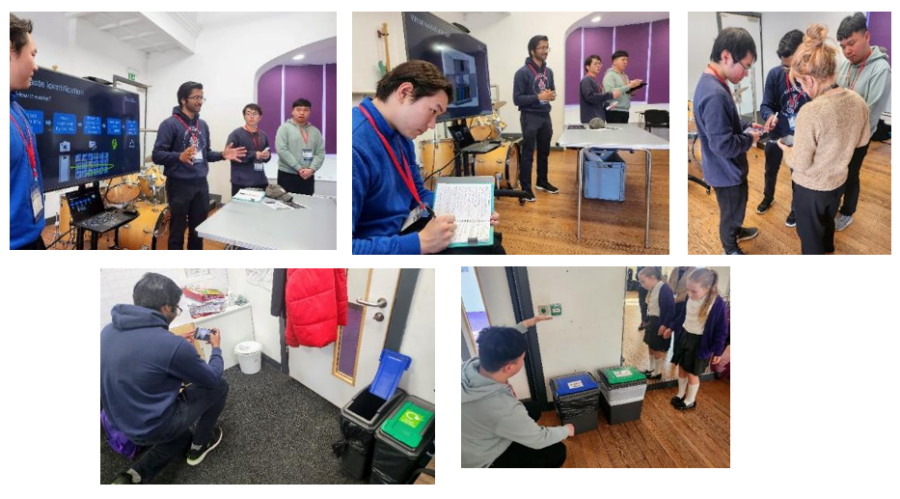
So what’s the next steps?
The team is on track to complete the Smart Recycling Bin prototype, after which they will test its performance and make any necessary improvements based on the results. Alongside the final stages of construction, they are continuing to use eco-audit software to evaluate the environmental impact of their design, including the materials used, production methods, operational footprint, and eventual disposal of components. This work is complemented by an ongoing collaboration with an Environmental Science student, who is specifically assessing the environmental cost of the computing elements—particularly the machine learning processes used to train the image recognition software. Together, they aim to identify how to reduce the project’s overall environmental impact by selecting more sustainable materials and determining the minimum AI usage needed to achieve reliable, automated waste sorting. These findings will inform the team’s final design recommendations, which will be submitted for academic assessment as part of their engineering degree programme.
The completed prototype will also be proudly unveiled to Maisie, whose idea inspired the project, and guests at the Primary Engineer Leader’s Award, ‘If you were an engineer, what would you do?’ Exhibition and Awards event, hosted at the University of Southampton in June!
For more information or to book your FREE tickets click here!
